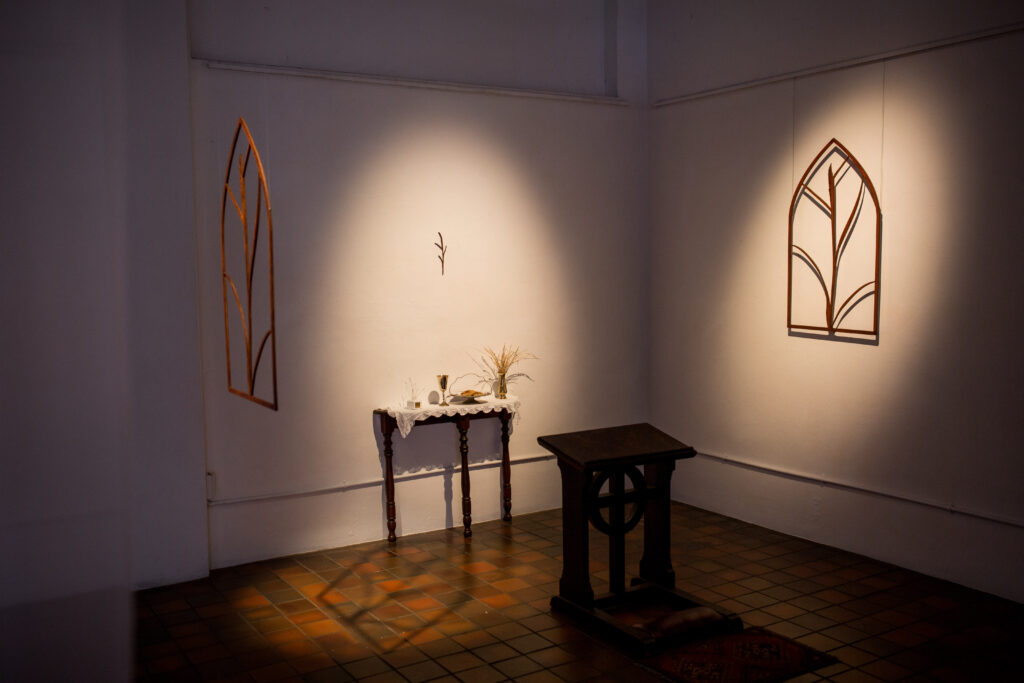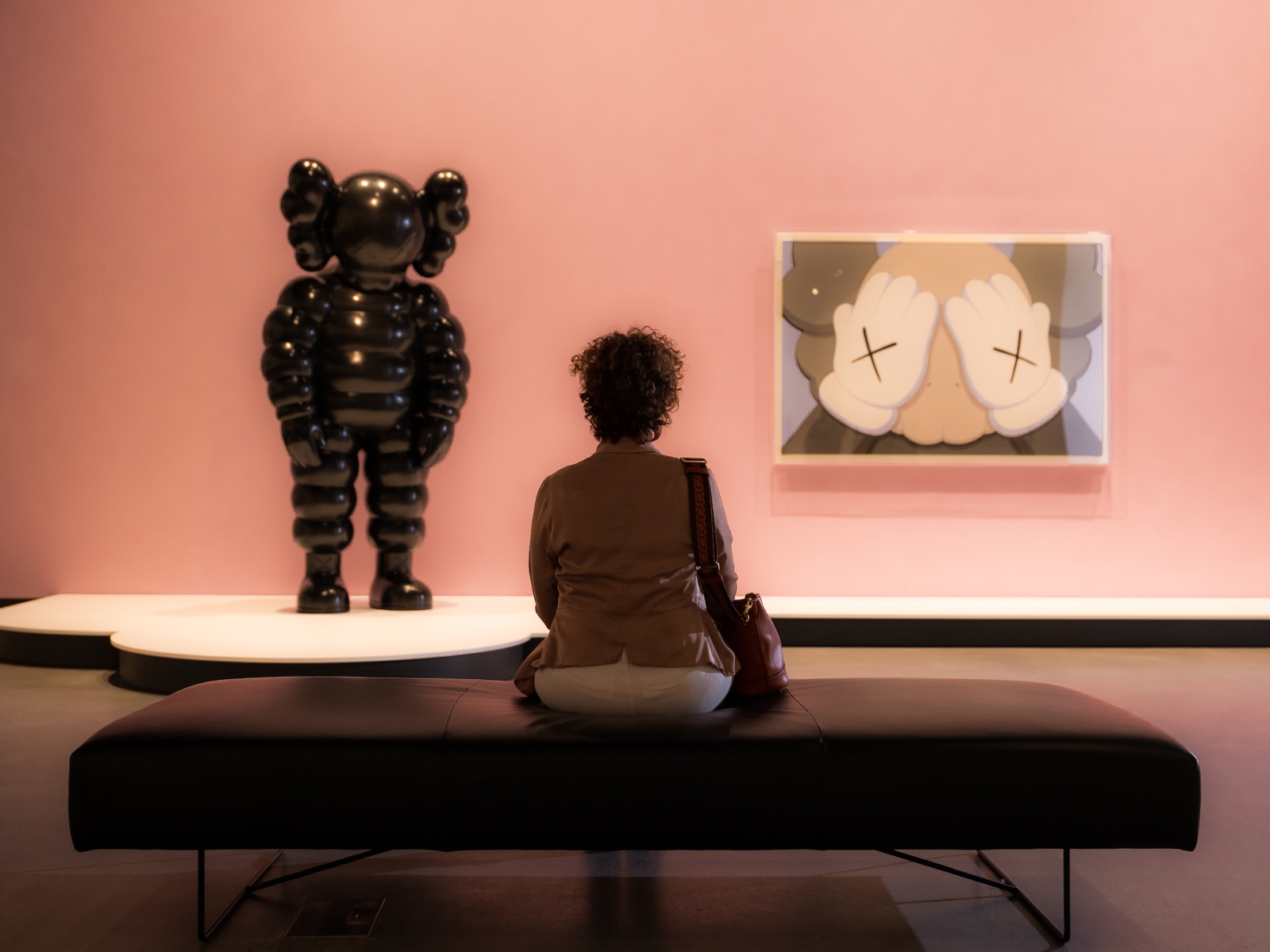
Aboriginal and Torres Strait Islander readers are advised that the following material contains images and names of deceased persons.
NO SOUVENIRS is a group show of selected emerging artists, born out of a six-month residency through Munimba-ja Art Centre’s Blak Camp and Blak Creatives Print Club. Artists have received mentorship from artists Libby Harward and Darren Blackman throughout, and the final exhibition was curated by Harward with curatorial assistance from Kellie O’Dempsey. Programs like these are essential in the ecosystem to provide dedicated guidance and space to produce work, especially outside the barriers of traditional university systems.
The show rejects the commodification of Blak art and the ways it’s historically been spun from the lens of tourist collectors. Front of mind for many contemporary First Nations artists is the reclamation of Indigenous Cultural and Intellectual Property (ICIP) from the harmful stereotypes that plague consumer culture. Spoofing, co-opting and re-appropriating this market is almost a rite of passage given the far-reaching impact of colonial violence.
Absorbing this project offered some insightful deviations of this rich tradition, whilst choosing to avoid the temptation of commercial irony that often sees artworks playfully mimic their targets. These works are not romantic, nor are they selling any fantasy. It appears they’ve unanimously denounced the idea of commercial appeal entirely. Each artist has staged their own intimate offerings exploring intergenerational war trauma, oppressive legislation to quell culture, and resisting colonial threats against the Blak feminine. A heady mix of topics for sure, but the show is efficient in its explorations and is anchored by hyper-specific individual storytelling.

Kabi Kabi artist Bianca Bond’s 1897 is a literal timeline of physical being, a writhing woven rope snakes along the walls and into the form of a woven bag, breaking off into several smaller isolated objects. Symbolic of the enriching communal celebrations of the Bunya tree harvest, which were outlawed entirely in 1897, the path represents a re-threading of time. Weaving here seemed almost a surrogate for DNA, its many spirals containing rich cultural knowledge inseparable from the body’s latent physical memory.

Rachel Bywater’s The Bread of Life, an installation centring the Ganalay (Curly Mitchell grass) and its significance to the Gamilaroi people and their continued agricultural practices. In front of a plinth was a small brown side table, doily-draped and displaying many religious curios, including a metal cup containing the titular Bread. Visually, the standout of this collection was a small white 3D printed tuft of the grass attached to a white base, reminiscent of a monument. A grass that was relegated by settlers as a weed is given the reverence of a patron saint of the land.

In a secluded alcove space was Wiradjuri artist Lexie Abel’s work – an alcove populated with family-home fixtures. Hanging on the wall was Nellie’s relic, a framed floral cross-stitch filled internally with little ‘AUSTRALIA’ pins replicated in black. I’m told it honours the artist’s second great-grandmother Nellie McCarthy, whose two brothers George Loftus McCarthy and Daniel Norman McCarthy fought in WWI. Tragically, George ultimately perished in France in 1918. Beside this resided a projected image of Nellie, her eyes staring back at me. Scaled to fit a family portrait frame, it added a level of immediacy and emotional vulnerability to the presentation. I was left pondering her legacy, and how many First Nations service people met the full brunt of war before returning home to a paltry sum – financially, socially and spiritually. I like the restriction of scale here, it feels respectful yet demanding of attention – a long overdue moment of public acknowledgement, carrying these memories across generations.

Gunagari and Mithaka artist Clea North presented an ambitious display of multiple works from her COLONIAL FETISH. My favourites are the pairing of For our Fallen, a giant printed banner of the iconic poem For the Fallen by Laurence Binyon with words redacted and reframed from an Indigenous historical perspective, and the striking photograph Crucifixion, depicting a young Aboriginal woman recalling the image of Christ as she’s crucified atop the Southern Cross. Both works speak powerfully to the perseverance of Blak women who endured in the face of rampant physical, emotional and sexual violence during the infamous Frontier Wars.
Brenda Mau’s Matriarchal Power suspends several stylized illustrations of Blak Women printed on large banners of organza silk, hanging from the ceiling, casting subtle motions across their bodies. They simultaneously broadcast strength through confidence of pose and, in an increasingly divided political landscape, force me to confront what strength has come to mean culturally. For me, the moments where the additional projected imagery overlays the silk are where this work shines. Casting these figures as they pulsate through the material like piercing a veil between worlds. I’d love to see this work expanded and taken further.

A moment that really struck me was a quietly captivating work from Wiradjuri artist Dimitie Smith. It first appeared an anomaly to me in its shyness. Hiding in the Grass sits atop a small stage-like platform in a far corner. Its surfaces painted black and dimly lit, it was enlivened by dozens of grass reeds sitting upward on its surface, reminding me of paddy fields. A tin shack stands in the centre with an image projected onto it, a shot from afar of many figures caught mid-corroboree, jarring and distant. It’s revealed to me that this seemingly gentle installation conceals a much darker truth. Smith details that this is a restaging of her father’s POV, as he used to play “hide in the grass” with his siblings; it was later revealed he was forced into doing so to avoid being abducted by authorities.

I thought this show was a generous presentation of new talent, who are clearly on the right track. As with the nature of emerging group shows, they can tend to be a mixed bag. I’m delighted to say it’s been a pleasure to see the breadth of work these artists are making. I enjoy that despite the visible finessing on show here, there still exists a sense of scrappiness. That’s not to say messy, but rather I sense a fearlessness to make a mess in the first place. To show up and confront this space as more than an Agreeable Aboriginal. I thank them all for their work, and for the creative team who ushered them here so supportively!
Those are my thoughts. If you found any of this useful or stimulating, please take note of their names and follow their trajectories. I know I’m excited to see how generous time will surely be to them.
Keemon Williams is an artist and curator currently based in Magandjin (Brisbane). He is currently the Assistant Curator Indigenous Australian Art at QAGOMA.



